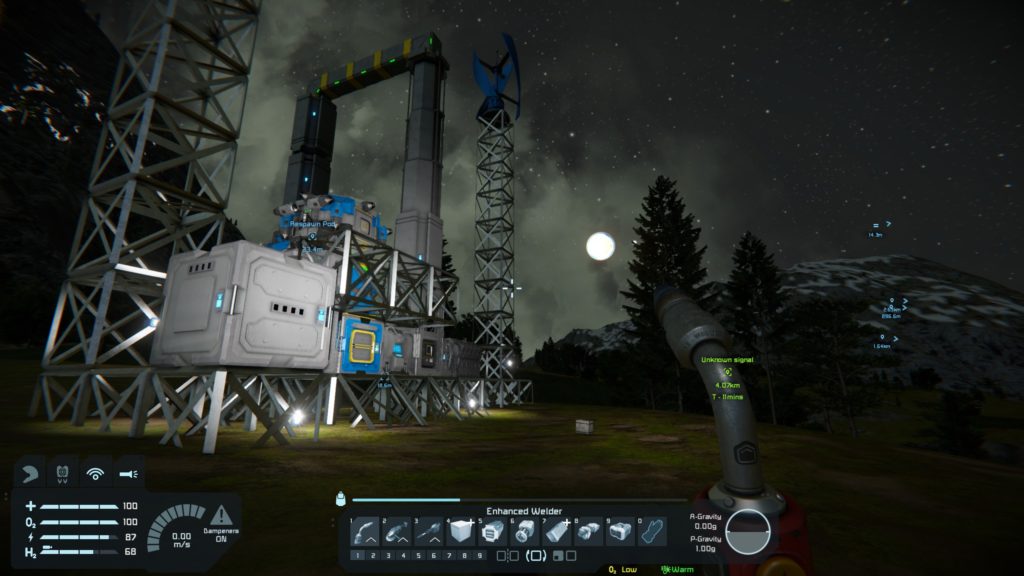Space Engineers is a voxel-based sandbox game set in space and on planets. It was developed and published by Czech Republic independent developer Keen Software House. Initially released in 2013 as early access, it just came out of early access earlier in 2019.
Space Engineers is a game about , well . . . engineers in space! It is a physics-based sandbox game in which you will explore planets and space, gather resources, build bases and vehicles, and–sometimes–crash them horribly. Space Engineers has been compared to Minecraft, where you can build almost anything. But with Space Engineers, you really can build ALMOST anything – literally! With accurate physics and gravity.

The game offers a number of starting scenarios, offline and online play, and two game modes–creative and survival. If you choose survival, you will not have to worry about food or water, but you will have to manage health, suit power, oxygen, and jetpack fuel while collecting resources to build your creations. Creative mode removes these limitations, but vehicles and other structures are still destructible.

The greatest features of Space Engineers are its physics and construction systems. Planetary gravity and mass are factors that need to be taken into account, and to make a fully functional flying vehicle, thrusters need to be placed in all 6 directions, in addition to at least one gyroscope. For construction, a huge number of blocks are available in both large and small sizes, and the configurability of functional blocks is astounding. For example, you can configure wheels to set maximum power, tire friction, suspension strength, desired height on the suspension, and more. You can attach ships with landing gear, dock them with connectors, create trailers and other moving parts with rotors and pistons, and much more. The possibilities are endless. You can even pilot vehicles by remote control and set autopilot protocol. There are also a great number of functional blocks with interesting applications. Apply welders to the underside of your ship’s armor plating to automatically repair it, create a grinding pit to drop salvaged bits into, warp up to 2000 km at once with a jump drive, or install an artificial gravity generator and reverse gravity on a whim. Space Engineers offers the opportunity to do all this and much more. And a great number of mods are available that add weapons, decorations, blocks, and well, anything you can think of.

But once you’re finished building something, you’ll have to be careful, because while you can build almost anything in SE, pretty much everything in Space Engineers is also destructible. One wrong move, and you could wreck a vehicle you spent hours building. I have severely damaged my ships on multiple occasions by neglecting to turn the power on or overloading them with cargo. Fortunately, you can save your vehicle designs before the worst happens with an extremely useful feature: blueprints. Blueprints allow you to save and recreate vehicles and structures in game. In creative mode, you can copy entire blueprints directly into the world; but in survival, you’ll have to use a projector to create an image of the blueprint, which you can then fill in easily with a welder and the necessary materials. With blueprints and projectors, recreating damaged, lost, or destroyed vehicles is much easier than building them again from memory. You can even set up automatic manufacturing systems with projectors and welder blocks. And if you don’t want to take the time to design your own vehicle, a wide variety of pre-made blueprints are available in the Steam workshop.

Space Engineers also includes enemy AI with random encounters and ship mounted weapons. You can build a mighty battle cruiser stocked with fighters, a highly armed rover, or a base bristling with defensive turrets. And if you become bored of facing AI foes, there’s a great amount of fun to be had going head to head with friends.
Overall, Space Engineers is a fun sandbox with some interesting and unique features. Its complexity might be off-putting to some, but if you like complex construction systems that reward patience and creativity with nearly endless opportunity, I would recommend this game to you.
The Verdict:
The Game Factor: Is it fun? 8/10
The Look Factor: Is the Style or Graphics good? 8/10
The Friend Factor: Is the game good with friends? 9/10
The “Jump-In” Factor: Is the game easy to learn/hard to master? 6/10
The Total Score: 8/10. If you liked Minecraft but want a bit more realism, get this game!
Written by Cuthalion42
Want to better understand how we rate games? Check out OUR RATING SYSTEM
Find us on Facebook: @atechgames
Come play with us as we raise money for kids at GAMERS FOR KIDS
Check out our live gaming stream: ATECHLIVE.COM
As always, we welcome your questions and comments. Feel free to contact us: HERE

